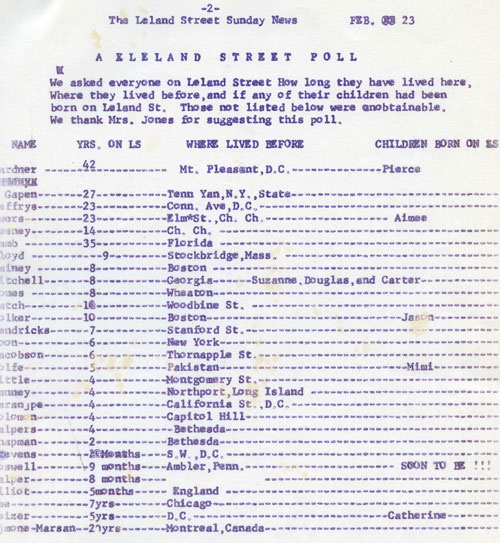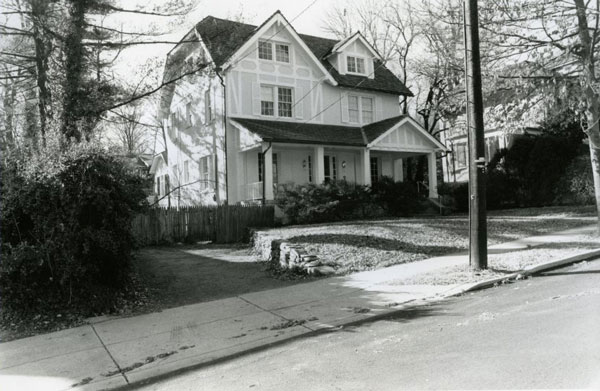Community Contributions
As the newspapers became increasingly more woven into the fabrics of these communities, the young reporters served a dual role of both informers and builders of community. By opening the newspapers up for personal news stories, letters to the editor and other content contributions, the children allowed neighbors to use the newspapers to express their opinions, offer suggestions or ideas and develop an increased sense of community awareness.
The Leland Street Sunday News, April 13, 1975. CCHS 2010.1015.02. “If you have the space, you might collect recipes on the street and publish one a week in the paper. Eventually you could put them together and have the Leland Street Cookbook of International Recipes.”
Written by Mrs. Lloyd, The Leland Street Sunday News, January 20, 1974. CCHS 2010.1015.01.

The Thornapple Street News, February 1, 1936. CCHS 1989.27.01. “Dear Editor: I wish all the people who litter Cummings Field should stop. Maybe then us kids could help keep it clean and pretty. Anonymous”
The Shepherd Street News, September 23, 1972. CCHS 1989.27.01. “Mr. Chapman suggested to the editors that they have a weekly weather forecast in the Leland Street Sunday News--Either from the Farmer's Almanac or the exact opposite of the weather forecast given the weather bureau. We chose the latter--see which is more accurate!”
The Leland Street Sunday News, February 9, 1975. CCHS 2010.1015.02.<
Issues of morality and awareness of crime or misbehavior figure prominently in the newspapers, a product of the editors' natural sense of fair play and conduct as much as that of community bonds.
The cycle of creating and investing in community through the newspapers does much to explain the success of the young reporters, and reveals the importance of the children's activities in fostering interaction and relationship building between neighbors. The newspapers may have begun as a tool for play and education, but the impact, and potential impact for similar newspapers today, was and is tremendous.
Community Connections
A note from an excited reader in Clarke County, VA. The Shepherd Street News, September 22, 1973. CCHS 1989.27.01.
While most of the reported events took place on these three streets or in the broader Chevy Chase neighborhood, the newspapers had readers from all over the country, many of whom had grown up in Chevy Chase. Some, such as the reader from Clarke County, seemed to have discovered the newspaper and enjoyed reading the news from a child’s perspective. College students had it sent to them at school and former residents kept up with local happenings. New neighbors often found a young reporter knocking at their door requesting information such as children’s ages, the parents’ occupations and family hobbies.
The Leland Street Sunday News, October 4, 1975. CCHS 2010.1015.02.
Graeme T. Smallwood Jr. (12 years old). The Thornapple Street News, October 8, 1931. CCHS 1989.27.01.
The editors emphasized the importance of getting to know one’s neighbors, and enjoyed finding out more about readers. In the Leland Street Sunday News this was often accomplished using polls:
The Leland Street Sunday News, February 23, 1975. CCHS 2010.1015.02.

The editors were also aware of the depth of history in their neighborhood and sought to incorporate the history of Chevy Chase into their newspapers.
The Thornapple Street News, November 28, 1931. CCHS 1989.27.01.
Having been inspired to start the Shepherd Street News after finding copies of The Thornapple Street News in their father's truck, the editors included a weekly "Old News" column featuring stories from The Thornapple Street News. This was a treat for readers who had grown up reading The Thornapple Street News or who remembered friends and family mentioned in the "Old News" stories. The editors of The Shepherd Street News were also aware of the older houses which existed nearby. One such house was part of what was the "No Gain" Plantation. A property of nearly three hundred acres in its day, "No Gain" played a crucial role in Chevy Chase history. Evidence such as the still standing farm house and log cabin (once thought to be slave quarters) sparked the curiosity of the children who now played and lived on the land.
Community evokes different images for each person. When we consider community we must expand beyond the limits of geography and look at the experiences, figures, and places which make up our fondest memories. Community is not always positive. Many frustrated Letters to the Editor in The Shepherd Street News testify to the conflicts and annoyances which can occur when humans live in a shared space. The work of the young reporters testifies to the importance of intentional community, and the cycle of creativity and support that can blossom when given the chance. Community members like Sue Patch recognized this, and thus when you ask anyone who lived on Leland Street where the heart of the Leland Street community is, they will point you to her front porch, where banana split parties, co-ops, and a neighborhood newspaper found their beginning.

In the next section, discover the wider world, and the events in it, as told to us by the young reporters.


